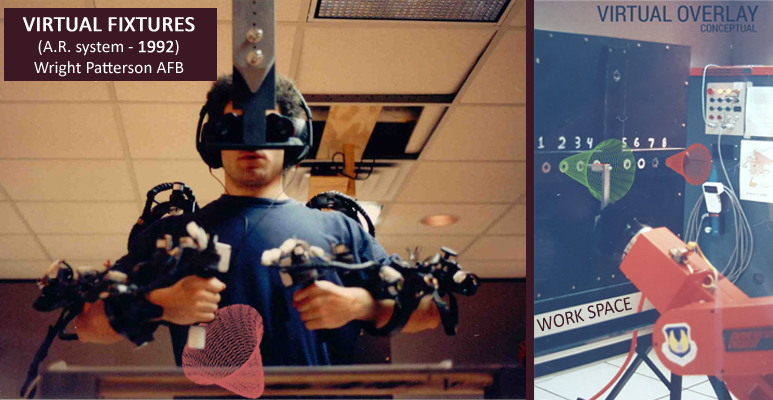什麼是『擴增實境』呢?
定義
目前對於擴增實境有兩種通用的定義。一是北卡大學羅納德·阿祖瑪(Ronald Azuma)於1997年提出的[1],他認為擴增實境包括三個方面的內容:
- 將虛擬物與現實結合
- 即時互動
- 三維
而另一種定義是1994年保羅·米爾格拉姆(Paul Milgram)和岸野文郎(Fumio Kishino)提出的現實-虛擬連續統(Milgram’s Reality-Virtuality Continuum)。[2]他們將真實環境和虛擬環境分別作為連續系統的兩端,位於它們中間的被稱為「混合實境」。其中靠近真實環境的是擴增實境(Augmented Reality),靠近虛擬環境的則是擴增虛境。
Augmented reality
Augmented reality (AR) , is a live direct or indirect view of a physical, real-world environment whose elements are augmented by computer-generated sensory input such as sound, video, graphics or GPS data. It is related to a more general concept called computer-mediated reality, in which a view of reality is modified (possibly even diminished rather than augmented) by a computer. Augmented reality enhances one’s current perception of reality, whereas in contrast, virtual reality replaces the real world with a simulated one.[1][2] Augmentation techniques are typically performed in real time and in semantic context with environmental elements, such as overlaying supplemental information like scores over a live video feed of a sporting event.
With the help of advanced AR technology (e.g. adding computer vision and object recognition) the information about the surrounding real world of the user becomes interactive and digitally manipulable. Information about the environment and its objects is overlaid on the real world. This information can be virtual[3][4][5][6][7][8] or real, e.g. seeing other real sensed or measured information such as electromagnetic radio waves overlaid in exact alignment with where they actually are in space.[9][10] Augmented reality brings out the components of the digital world into a person’s perceived real world. One example is an AR Helmet for construction workers which display information about the construction sites. The first functional AR systems that provided immersive mixed reality experiences for users were invented in the early 1990s, starting with the Virtual Fixtures system developed at the U.S. Air Force’s Armstrong Labs in 1992.[11][12][13]

Virtual Fixtures – first A.R. system 1992, U.S. Air Force, WPAFB
或許你早已見識過了!
精靈寶可夢GO
《精靈寶可夢GO》[6][7][8](英語:Pokémon GO),是一款基於位置服務的擴增實境類手機遊戲,由任天堂公司、精靈寶可夢公司授權,Niantic, Inc.負責開發和營運。於2016年7月起在iOS和Android平台上發布[9]。該遊戲允許玩家以現實世界為平台,捕捉、戰鬥、訓練和交易虛擬怪獸「寶可夢」[10]。遊戲將免費發布,亦支援內購[11]。同該遊戲同期發布的還有一部名為精靈寶可夢Go Plus的周邊設備,利用藍牙連接手機,在附近有精靈寶可夢時推送通知[10]。
2016年3月4日,Niantic宣布在該月下旬將在日本獨占進行內測,允許玩家在遊戲正式發布前參與對遊戲的改進[12]。4月7日,內測擴展到澳大利亞和紐西蘭[13]。5月16日,針對美國開放內測申請[14][15]。2016年7月6日在澳大利亞和紐西蘭發行、7日在美國發行。遊戲發布後,任天堂的股票價格在一天內暴漲9%[16]。任天堂在東京交易所的股價,兩週內急漲100%;遊戲發布前的7月6日收盤價14380日圓,到了7月19日股價上漲突破了3萬日圓[17]。截至2016年8月1日,遊戲的下載量在全球範圍內已超過1億次[18]。於2016年12月12日開放部分第二世代寶可夢[19][20],於2017年2月17日開放大多數第二世代寶可夢[21],於2017年6月20日更改道館對戰機制並推出團體戰[22]。
所謂『谷歌紙板』
Google Cardboard是Google開發的與智慧型手機配合使用的虛擬現實頭戴式顯示器。該平台以其摺疊式紙板頭盔命名,旨在作為一種廉價成本,激發對VR應用的興趣和發展[1][2]。按照Google發布的規範,用戶既可以利用廉價簡易的元件自行製作頭盔,或購買預先做好的頭盔。要使用平台,用戶須在手機上執行Cardboard相容的應用,將手機置於頭盔後端,透過鏡片觀看內容[3]。
該平台由巴黎Google藝術文化學院工程師大衛·科玆(David Coz)和達米恩·亨利(Damien Henry)利用他們20%「創意休息時間」(Innovation Time Off)開發[4],於2014年Google I/O開發者大會上亮相,被派發給現場所有觀眾。Cardboard的軟體開發套件(SDK)向Android和iOS作業系統開發。SDK的VR View允許開發者嵌入網路及他們行動應用中的VR內容。
到2017年3月,Cardboard發貨量超過1000萬個,1.6億個Cardboard應用程式上線。乘著Cardboard平台的成功,Google在2016年的Google I/O上宣布了增強VR平台Daydream。
當然也是『抬頭顯示器』哩!
HUD
A head-up display, also known as a HUD, is a transparent display that presents data without requiring users to look away from their usual viewpoints. A precursor technology to augmented reality, heads-up displays were first developed for pilots in the 1950s, projecting simple flight data into their line of sight thereby enabling them to keep their “heads up” and not look down at the instruments. Near eye augmented reality devices can be used as portable head-up displays as they can show data, information, and images while the user views the real world. Many definitions of augmented reality only define it as overlaying the information.[32][33] This is basically what a head-up display does; however, practically speaking, augmented reality is expected to include registration and tracking between the superimposed perceptions, sensations, information, data, and images and some portion of the real world.[34]
CrowdOptic, an existing app for smartphones, applies algorithms and triangulation techniques to photo metadata including GPS position, compass heading, and a time stamp to arrive at a relative significance value for photo objects.[35] CrowdOptic technology can be used by Google Glass users to learn where to look at a given point in time.[36]
In January 2015, Microsoft introduced HoloLens, which is an independent smartglasses unit. Brian Blau, Research Director of Consumer Technology and Markets at Gartner, said that “Out of all the head-mounted displays that I’ve tried in the past couple of decades, the HoloLens was the best in its class.”.[37] First impressions and opinions have been generally that HoloLens is a superior device to the Google Glass, and manages to do several things “right” in which Glass failed.[37][38]
雨後彩虹見,
ArkwoodAR Documentation
ArkwoodAR is a Python Augmented Reality application for Google Cardboard.
To see how it works, check out my ArkwoodAR video.
Software requirements
Here are the dependencies, each with their recommended version number:
- Python 2.7.11
- PyOpenGL 3.1.1b1
- OpenCV 2.4.9
- NumPy 1.10.1
- PIL 1.1.7
預卜 3D 腳步近了也◎

